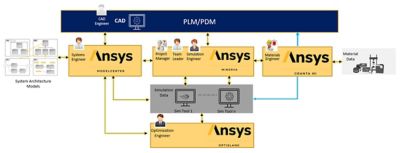-
-
学生向け無料ソフトウェアにアクセス
Ansysは次世代の技術者を支援します
学生は、世界クラスのシミュレーションソフトウェアに無料でアクセスできます。
-
今すぐAnsysに接続!
未来をデザインする
Ansysに接続して、シミュレーションが次のブレークスルーにどのように貢献できるかを確認してください。
国および地域
無料トライアル
製品およびサービス
リソースとトレーニング
当社について
Back
製品およびサービス
Ansysブログ
December 8, 2023
PLM、SPDM、マテリアルインテリジェンスでデジタルスレッドを完成
世界中の多くの業界がデジタルトランスフォーメーションによる影響を受ける中、製品を開発する企業は、拡大し続ける大量のデジタル情報を管理し続けなければならないという問題に直面しています。これまで多くの企業は、何十年にもわたって製品ライフサイクル管理(PLM)システムを使用して、コンピュータ支援設計(CAD)データを追跡して管理してきました。しかし、製品開発プロセスの不可欠な部分としてシミュレーションを活用する機会が増え、シミュレーションで生成されたすべてのデータを追跡して管理することが困難になっています。シミュレーションプロセスおよびデータ管理(SPDM)は、こうした問題を解決します。
SPDMとPLMは、いくつかの類似点があり、同義として扱われることもありますが、実際には同じものではありません。PLMシステムは、CADデータを管理するために長年にわたって進歩してきました。また、CADファイルの整理方法や制御方法に関する具体的な要件に対応するために、その機能も最適化されています。シミュレーションデータは、CADデータと大きく異なるため、効果的に管理するには別の機能セットが必要です。PLMは設計エンジニア向けに設計されていますが、SPDMはシミュレーションアナリストやシミュレーションエンジニアのさまざまな要件を満たすように設計されています。PLM企業の多くは、シミュレーションアナリストのニーズに対応するために、PLMシステムへのアドオンモジュールを開発してきました。しかし、こうした取り組みに反して、PLMシステムは、シミュレーションデータやプロセスに対応するために特別に設計されたSPDMシステムほど、その目的には適していません。
シミュレーションデータに対応するために既存のPLMシステムを拡張できると企業が想定するのは自然な考え方ではあるものの、実際には極めて効率が悪くなります。シミュレーションエンジニアに固有の要件や、シミュレーションで生成されるデータを扱うために最適化されたSPDMシステムを追加することが、PLMの価値を拡大するより良いアプローチです。Ansys MinervaのSPDMソリューションは、既存のPLMシステムとシームレスに統合されます。Ansys SPDMソリューションを導入することで、企業は確立されたワークフローを維持して強化できるだけでなく、さまざまなツールとの相互運用性が提供されることで、シミュレーションファイル、マテリアルインテリジェンス、PLMデータなどを含む完全なデジタルスレッドを作成できるようになります。自社のPLMソリューションをMinervaと統合することで、より複雑なワークフローを管理し、作業を追跡することが可能になり、持続可能性が向上します。
完全なデジタルスレッドを作成
Minervaは、材料管理ソフトウェアのAnsys Granta MI Enterprise、プロセス統合および設計最適化ソフトウェアのAnsys optiSLang、モデルベースシステムズエンジニアリング(MBSE)ソフトウェアのAnsys ModelCenterなどが含まれるAnsys Connect製品ファミリーに属する製品です。これらのAnsys Connect製品は、相互かつシームレスに統合できるため、Minervaを介して既存のPLMシステムに簡単に統合できます。持続可能性への懸念が世界的に高まる中、特にマテリアルインテリジェンスはあらゆる企業にとって大きなアセットとなります。

Ansys Connect製品で、完全なデジタルスレッドを作成できる
マテリアルインテリジェンスは、社内外の運用の持続可能性に大きく貢献します。物理的、化学的、または機械的なコンポーネントの材料特性と、そうしたコンポーネントの毒性、二酸化炭素排出量、リサイクル可能性に関する詳細を把握することで、よりクリーンな材料を選択できます。より優れた材料を選択することで、企業が掲げるサステナビリティゴールに合わせて、製品が環境に及ぼす悪影響を減らすことができます。さらに、このデータをデジタルスレッドに取り込むことで、マテリアルインテリジェンスのメリットが増大し、概念化の初期段階から生産の最終段階まで、設計と開発にとって有益な情報となる重要な知見を得られるようになります。
Minervaのアーキテクチャはベンダーに依存しないため、既存のPLMワークフローやGrantaと容易に統合できます。そのため、社内のPLMシステムからMinervaやGrantaへ、設計データを移行する必要はありません。Minervaではデジタルスレッドが作成され、シミュレーションデータ、マテリアルインテリジェンス、関連ファイルが既存のPLMシステムのCADデータや設計データに接続されます。デジタルスレッドを作成することで、設計や開発チームはプロジェクト全体を管理できるようになり、トレーサビリティ、接続性、組織全体の部門間でのコラボレーションが向上します。

Ansys Minervaは、既存の製品ライフサイクル管理(PLM)ワークフローや他のAnsys Connect製品と簡単に統合できるため、包括的なデジタルスレッドを作成できる
トレーサビリティが確立されると、製品ライフサイクル全体にわたってデータを追跡して監視できますが、それだけではありません。Minervaのトレーサビリティ機能、Grantaとの統合、既存のPLMシステムとの相互運用性により、正しいバージョンのファイルを見つけ、さまざまな開発ポイントから普遍的な変更を簡単かつ正確に行うことができます。
たとえば、最終的に目指している技術要件や仕様を満たすCADモデルを作成したとします。環境への配慮から、それらの要件や材料を変更しなければならない場合は、CADモデルを変更する必要があります。では、どのバージョンのモデルを変更すれば良いのでしょうか。また、新しい材料に変更した場合は、どの材料データを採用すべきでしょうか。シミュレーション、材料、PLMデータをすべて含むデジタルスレッドを作成できれば、推測に頼ることなく、チーム間で情報を伝達し、正しいモデルバージョンを見つけて、設計変更に対処するために必要な手作業や煩雑なやり取りを大幅に減らすことができます。つまり、完全なデジタルスレッドは、単なるトレーサビリティだけでなく、正確なトレーサビリティをもたらします。
独自の専門知識を活用してPLMとSPDMを強化
一部のPLMシステムでは、シミュレーションデータを管理するためのアドオンモジュールが提供されていますが、理想的なソリューションとは言えません。なぜなら、シミュレーションデータ用に設計されていないPLMシステムは、管理や処理を行うために最適化されていないため、目的を完全には遂行できないためです。アドオンモジュールを追加することは、既存のシステムに付属品を取り付け、本来は意図されていないことを達成しようとするようなもので、完全なソリューションのようには機能しません。
製品開発会社で広く採用されている別のシステムを考えてみましょう。一般に、企業は在庫、注文、会計などの製造データを管理するためにエンタープライズリソースプランニング(ERP)システムを利用しています。通常、製品開発会社の事業運営面はERPシステムで、設計エンジニアリング面はPLMシステムで管理しています。どの企業もPLMシステム内でERPプロセスを実行しないように、PLMシステム内でシミュレーションプロセスを実行するべきではありません。そのように設計されていないからです。PLMはCAD処理とデータ管理向けに最適化され、ERPは製造プロセス管理向けに最適化されています。同じように、Minervaは、シミュレーションとSPDM向けに最適化されています。
PLMへの包括的なアプローチ
多くの企業がデジタルスレッドを作成しようとしており、すでに達成できたと考える企業もあるでしょう。しかし、デジタルスレッドにシミュレーションデータが含まれていなければ、そのデジタルスレッドは完成しているとは言えません。シミュレーションデータと材料データをデジタルスレッドに取り込むことで、ワークフローのあらゆる領域にわたり、より完全な接続性を実現することができます。
同様に、PLMシステムだけでシミュレーションデータを管理している企業は、PLMに対して包括的なアプローチを取っているとは言えません。PLMと連携して動作するSPDMソリューションは、より完全で包括的なデジタルスレッドを作成できる環境を生み出し、マテリアルインテリジェンスなど、追加の知見を取り込むことでさらに改善します。
SPDMソリューションが具体的にどのようなメリットをもたらすか、Minervaの無料トライアルで実際にご確認いただけます。また、材料ソリューションでどのようにビジネスを改善できるか、Grantaの無料トライアルで実際にご体験ください。